The jump uniform was made from 8 oz. cotton twill. This fabric is also used for the shells of tankers, Arctic M41's, some Mackinaws and a handful of M41 Field jackets. The wool overcoat also uses it for a lining. It is tough, but relatively lightweight. The twill is not nearly as heavy as denim. The color was olive drab no. 3, which is often erroneously called "khaki" by novices. The actual color varies widely from uniform to uniform- it ranges from grass stain green to a golden tan. Faded uniforms generally look more "khaki".
|
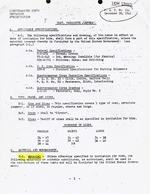
|
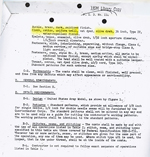
|
|
December 1941 spec for the jump jacket. Note the size tariff.
|
Materials list. Obviously, some changes were made after this was printed. I've yet to see oxidized bronze snaps...
|
The jackets were made in even sizes 34-44, regular, long and short. No, they didn't make odd sizes then either...
|
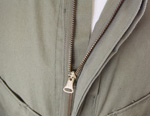
|
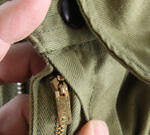
|
|
|
Typical main zipper.
Conmar.
|
Knife pocket zipper- usually Conmar or Serval.
|
Armpit vents
|
The jacket has 4 angled pockets- the lower ones being slightly larger than those on the breast. Small pockets for pens or pencils are provided inside the breast pockets. Note: the shape of the pocket flaps varies from maker to maker- some have very sharp corners, others are rounded. The front is closed via a zipper- usually a Conmar or Prentice, but Talons have been observed. At the throat, a small pocket is built into the placket to hold the switchblade. In case of being entangled in his parachute harness or suspension lines, this location would be accessible for the trooper- unlike his hip or jacket pockets which were covered by the harness straps. This pocket could be opened from the right or left side by operating a pair of small zippers- most commonly Serval or Conmar brand. Four air vents are provided in the armpits- early jackets used sewn eyelets while later ones tend to use metal grommets like HBT caps.
As for modern zippers- Conmar and Talon are now just names one pays to have stamped on zippers. Originals used stamped brass or steel- today only cast pot metal is available. I have been looking for a company that can do the stamped brass for 15 years and so far no luck. The "brass" is simply a gold colored plating- it looks like cheap costume jewelry- so we use dull steel Talons on our uniforms. It's the closest thing we can get and they look good.
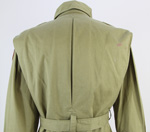
Bi-swing back
The back of the jacket featured a "bi-swing" back- a series of long pleats allowing the uniform to expand when the trooper needed to move his arms. A belt was provided at the waist to keep the jacket close to the body. Most early paratrooper uniforms busied themselves trying to avoid catching wind and bellowing up- when in practice the soldier's field gear and parachute harness took care of this.

Snap variations
Both the jacket and trousers used press snaps to close the pockets, cuffs, collar and epaulets. All snaps used blackened caps. However, the parts underneath vary depending on when the uniform was made. The early production suits used brass (often very poorly set), most used zinc plated steel (which turns gray with age) and a few late examples have black steel. The finish on the cap has often worn off of heavily used used uniforms leaving them brass or steel in color. But when new they were blackened.
As for our reproductions, I prefer the zinc type as they are the most common, and with some wear and tear they will begin to oxidize and look old. We have to special order them from Scovil- and they aren't cheap.
Jacket Production Variations: The jump uniform was only in production for a little over a year (42-43). There are two main groups I have seen. The early jackets may have been largely made by one company. The have no spec label (thus we don't know the company or date), but they have brass snaps, darker o.d. thread, and tend to be greener in shade. The snaps are almost always poorly set. The jacket at the top of the page is one of them. I have owned about 6 over the years, several being unissued.
The later, more common jackets are very consistent, varying mostly in snap type and pocket shape (sharp or rounded corners). Makers include Sigmund Eisner and Goodall.
Jump Trousers
|
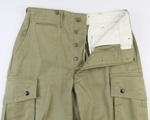
|
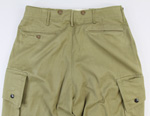
|
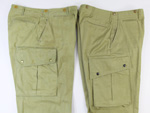
|
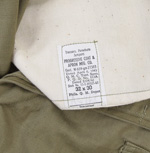
|
|
Button fly, watch pocket,
narrow belt loops
and suspender buttons
|
We didn't forget the button-
the War Department did.
|
Pocket size and shape varies
slightly between trousers.
|
Spec label is usually
on the underside of
the right front pocket lining.
|
The jump trousers were very similar in cut to today's BDU trousers. They were made in even waist sizes from 28-36. The shell was the same 8 oz twill as the jacket and the pocketing was white, unbleached twill or poplin. Belt loops and buttons for suspenders were provided. On each hip was a large cargo pocket with a bellows. Two slash pockets were provided at the waist and two on the rear- the left one being the only one secured with a button.
Early production jump trousers had a V-shaped panel of wool knit at the cuff to facilitate tucking them into jump boots. Later trousers dispensed with this feature and had a simple, slightly tapered ankle with binding tape.
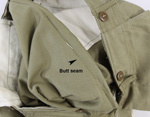
Inside of butt. Note stitches already pulling loose.
The jump trousers had one marked weak spot- the butt. The rear center seam was closed with a single stitch- it should have been felled (folded on itself) and sewn with a double needle. This led to constant blow outs. Most original trousers show repairs in this spot. Our trousers usually have extra stitching at this point to help prevent blowouts. (I say "usually" since as soon as I say "always" someone will prove me wrong. I check them at random and so far all were good to go.)
Reinforced Uniforms: (Like an idiot, I sold my reinforced uniform several years ago when I was offered an insane amount of money for it, so no photos at this time.) If someone has good clear pictures of their original reinforced uniform I'll be glad to post them.
After the first combat operations in North Africa and Italy, it became apparent that the M1942 had some weak points as the cotton twill was not heavy enough for the rigors of combat. If a trooper had a hard parachute opening, the shock caused the contents of his pockets to literally explode through the cargo pockets. So, in the Spring of 1944, the 82nd and 101st initiated a crash program to reinforce the jump suits of troopers going to Normandy. Each man was told to turn in his most worn out suit to be altered. The divisional riggers (parachute packers/ repairmen) acquired some heavy canvas and added patches to the pockets, elbows and edges of the cargo pockets of most men's suits. The canvas is rather unique- it is not normal olive drab G.I. material. It tends to fade to a grayish tint and has some sort of water proofing. It's similar in color to Austrian duffle bags for those of you who know what they look like. Perhaps it was some sort of aircraft cover fabric? The sewing on the reinforcing tends to be rather sloppy- after all, it was sewn in a hurry by teenagers who likely had a hangover. Crooked seams and uneven panels being the norm. Quite frankly, it usually looks like sh*t. If we duplicated that, we'd get a lot of returns with people howling "it's falling apart!".
To imitate the original cloth exactly is nearly impossible. For one, I don't have a piece of it to send the mill. I'm not going to ship off a $10,000 jacket. Second, to custom weave a fabric is usually a 5-10,000 yard minimum. Canvas is $5-7 per yard....do the math. Lastly, if it was the digny gray-green like originals, many living historians would probably complain that is wasn't "OD" and therefore wrong. For those of you who do know what originals look like- please know that I know too. But it's just not practical. I am truly sorry- I wish it were.